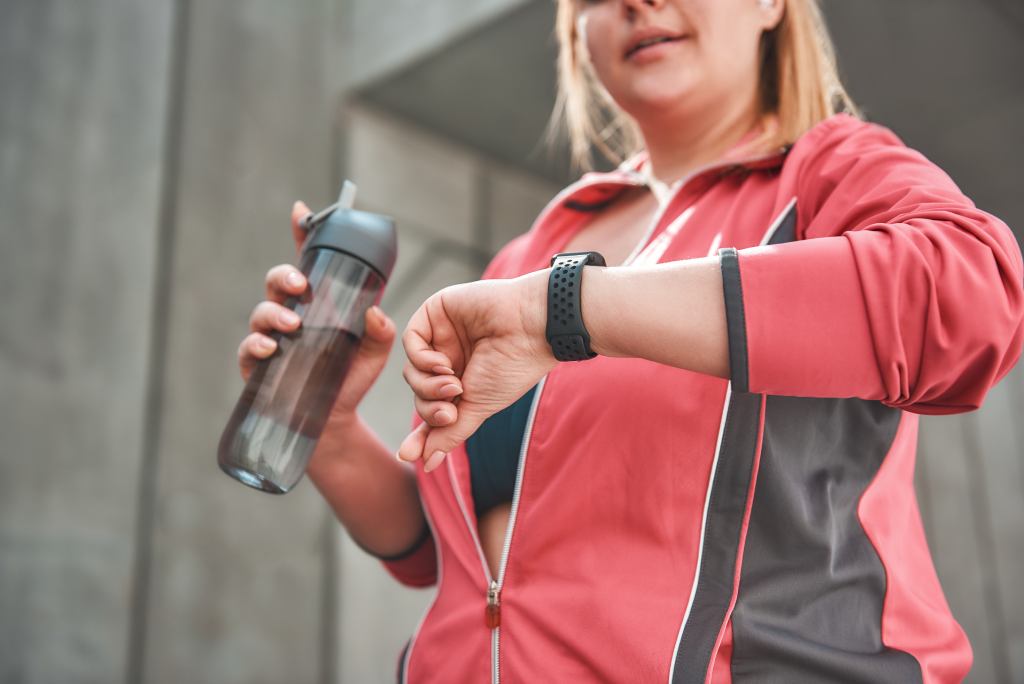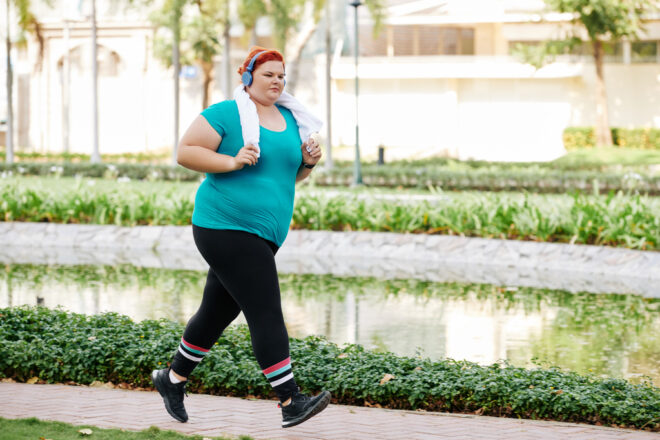Is running good for weight loss? Yes, it can burn more calories than swimming, cycling, or weight training, according to the American Council on Exercise.
Running for weight loss is effective because it enhances cardiovascular health and accelerates metabolism. Combined with a balanced diet, it can also promote lean muscle mass growth for optimal calorie burn and weight control.
But to burn the most calories when running, you have to do it right. Steady-state running is not as effective as high-intensity interval running, though it can still help beginners.
Regular running also helps to maintain optimum weight, which can protect your joints from wear and tear in the long run. Some studies have even shown that running can be protective against knee pain.
But while running alone is beneficial for your health, it should be combined with a nutrient-dense, low-calorie diet and some strength training for best results.
Read on to find out more about how running can accelerate weight loss and whether it burns belly, stomach, and thigh fat.
In This Article
In This Article:
The Big Question: Does Running Burn Fat?
In short – yes, running does burn fat, as it uses the fat stored in your body for energy. However, the answer is not that simple, as several factors come into play here.
How much fat you’ll burn while running will depend on your body weight, gender, running speed, terrain inclination, and weather conditions. Even the surface you run on can affect the result.
Running apps and fitness bracelets can automatically log how many calories you burn based on your weight, speed, type of exercise, and other factors. Having one makes tracking the calories you burn so much easier.

When Does Your Body Burn Fat?
During physical activity, your body first burns glycogen, a type of glucose it stores in the liver for energy. Your body only starts to burn fat after around 30–60 minutes of aerobic exercise, such as jogging or running.
You can think of energy as calories. To burn 1 gram of body fat, you’ll need to burn 9 calories from fat. But how many calories do you burn while running? A well-known rule states that the average runner burns around 100 calories per mile.
However, this number won’t be equal for everyone. A lighter person will burn fewer calories than a heavier one, and vice versa. For a more accurate measurement, you can use a simple calorie burn rate calculator that factors in your weight and running pace.
High-intensity interval vs. low-intensity long run: what burns more fat?
Both longer, moderate-intensity runs and high-intensity, interval runs work. However, studies show that the latter is more effective in burning fat.
Why? Due to the high-intensity of fast or interval runs, the total calorie consumption is also higher. In fact, HIIT training done at 80% or more of your normal heart rate can help you burn up to 28.5% more fat than lower intensity long-distance running.
HIIT produces metabolic changes in the body that promote weight loss. After such workouts, our bodies continue to use energy to recover, which is called the after-burn effect.
However, HIIT workouts are more taxing and require a longer resting period, especially if you’re coming back to running after some weight gain. Lower-intensity long runs are easier to keep up and recover from, so in the beginning, they can help you burn more weekly calories than HIIT.
When you walk or exercise at a low intensity, your muscles burn a higher percentage of fat than carbohydrates and use more oxygen compared to running or exercising at a higher intensity. However, running burns more total calories, which contributes to greater weight loss.
For example, a 130-pound person walking at a pace of 5 miles per hour will burn 472 calories. The same person running at 6 miles per hour will burn 590 calories.
Good to know: Running on a treadmill also burns fat. For obese runners, treadmills are easier on the leg joints than most running surfaces and can reduce the risk of injuries.
Does Running Burn Belly Fat?
Yes! Research indicates that moderate to high-intensity running can reduce belly fat mass even if you don’t change your diet. Belly fat increases the risk for type 2 diabetes, heart disease, and other diseases, according to an article published in the journal Circulation.
There’s a strong link between high-intensity interval training (HIIT) and fat burning. HIIT, such as interval runs, is more likely to result in noticeable weight loss than running consistently at a slow-to-moderate pace, according to this study.
As mentioned before, this happens because high-intensity training creates a stronger afterburn effect, in which your body continues to burn calories even after you’ve finished running.
The afterburn effect is stronger in the hour after the run but can last for up to 48 hours. What’s more, high-intensity running suppresses appetite so that you’re less likely to take in a lot of calories after your runs.
The bottom line: Running is an effective way to burn excess fat, but not all types of running provide the same results. You can burn more calories with HIIT, but you have to be careful to avoid injury and give yourself time to recover.

How to Run to Lose Weight
New to running? You can optimize your runs to burn more fat by following a beginner’s plan. Here are some tips that can complement your plan.
Just start
Starting is often the hardest part of any weight loss journey, and running is no exception. Don’t lose yourself in research or seek the ultimate best strategies for quick results – you won’t burn calories just by thinking about burning calories!
Just start running, even if, in the beginning, you do short, low-intensity runs. By getting you moving, these early runs will play a major role in your journey to weight loss.
If you need extra motivation and an easy way to track your progress, the Joggo app is a great companion to support your journey. Tell us about your needs, goals, and lifestyle, and we’ll design a fitness experience tailored just for you:
- Personalized running plan according to your schedule and fitness level
- Meal plan created around the foods you love, plus a weekly grocery list
- Friendly and motivating audio guide to support and cheer you on
Warm up before running and cool down after
Stretching and other warm-up workouts increase your heart rate, warm up your muscles, increase your body elasticity, and prepare you for a run.
Warming up before running makes your muscles perform better and reduces the risk of injuries. It makes it easier for you to reach your weekly running goals.
Cool-downs are equally as important, although they often get overlooked. Cooling down after running gradually decreases your heart rate, preventing a sudden drop in blood pressure. Additionally, stretching your muscles can relax them, reducing post-workout soreness.
Best running workouts for weight loss
As discussed before, high-intensity running will burn more calories compared to low-intensity sessions. But which workouts exactly should you opt for?
High-intensity, interval running burns fat most efficiently. By giving your heart, lungs, and muscles a strong push, they boost your fitness level like no other type of running workout.
Interval runs involve alternating between high-intensity and low-intensity periods, enabling you to build both speed and endurance. Below are some examples of interval running workouts you could try:
- 30/30 workout: Sprint for 30 seconds, then walk or jog for 30 seconds. Repeat for 10–20 minutes.
- 400-meter repeats: Run 400 meters at a high-intensity pace, then jog or walk for 400 meters. Repeat 4–6 times.
- Fartlek workout: Start with a 5-minute warm-up jog, then alternate between 1-minute sprints and 1-minute jogs for 10 minutes, ending with a 5-minute cool-down jog.
Tip: Avoid pushing yourself beyond limits, and don’t be afraid to experiment to find the workout you like the most. If you don’t enjoy a workout, it’s not likely you’ll stick with it.
Consider cross-training
Cross-training on days when you’re not running conditions your body by working more than your lower body muscles.
It promotes active recovery, builds endurance, makes you stronger, and reduces the risk of injuries.
Cross-training can include doing jumping jacks, push-ups, rope jumps, and squats, as well as lifting weights, swimming, cycling, or kayaking. Alternatively, you could try trail running to switch up your running routine and exercise in nature.
Balanced meals
If you’re considering running for weight loss, don’t forget to complement your routine with a nutritious diet. A balanced diet provides the necessary nutrients for our bodies to function optimally, promoting muscle recovery and fueling our workouts.
By combining balanced meals with regular running, fat burning can be significantly enhanced. Consume a well-rounded diet of protein, fats, and carbohydrates to ensure that your body gets the energy it needs while still promoting weight loss.
For example, aim for a protein-rich breakfast like eggs or Greek yogurt to fuel your body and keep you satiated. Opt for complex carbs like sweet potatoes or brown rice before your run for long-lasting energy, and finish with lean protein post-run to help with muscle recovery.
Remember: Consuming meals too close to your run could lead to discomfort while eating too far in advance might leave you feeling lethargic. A rule of thumb is to have a small, carb-based meal 1–2 hours before running and replenish your energy with protein and carbs post-run.
Looking for low-calorie, nutritious recipe ideas to complement your running routine? Take the quick Joggo quiz, tell us about the foods you love, your goals, and lifestyle, and we’ll create a fitness routine carefully tailored to your needs.
- Save time with thousands of delicious recipes, plus a weekly grocery list
- Run on your own schedule, whether it’s on a treadmill or outdoors
- Feel unstoppable as you listen in to our friendly and motivating audio coach
- Keep your motivation up as you complete streaks and collect digital rewards
Strength training
While running has multiple benefits for your body and mind, it largely focuses on cardiovascular endurance and lower body strength and is not enough for a holistic fitness routine.
That’s why running should be complemented with strength training, as it enhances the power of different muscle groups, stabilizes joints, helps prevent injury, and optimizes overall health. Importantly, it can help ensure you keep the correct posture and run properly.
You could incorporate these strength exercises into your routine to ensure a balance and effective workout regimen:
- Planks: Planks target the core muscles, improving stability, balance, and posture during runs.
- Lunges: Lunges are great for working the hips, glutes, quads, and hamstrings, mimicking the running motion and improving stride efficiency.
- Deadlifts: This exercise strengthens the posterior chain (glutes, hamstrings, and lower back) essential for powerful strides and maintaining a strong upright posture.
- Push-ups: Push-ups work on upper body strength, helping runners maintain a relaxed, upright posture during long runs.
- Squats: This exercise strengthens the quads, glutes, and hamstrings, which are key muscles for runners.
How Long to Run to Burn Fat?
If you’re here, you’re probably wondering what exactly your running routine should look like to start burning fat and get in shape faster.
Running every day is not necessary to burn more fat. But frequency matters, so you want to put in 3–5 running sessions every week of at least 30 minutes each and preferably more, up to 60 minutes.
High-intensity types of running can help you burn calories up to 48 hours after your workout. These include interval runs and hill repeats. It’s the afterburn effect, which results in significantly more calories burned over time.
A study found that exercising vigorously for 45 minutes is enough to increase your metabolic rate for 14 hours.
The bottom line: Depending on your level, you can put in longer low-to-moderate intensity runs or focus on high-intensity training to tap into the afterburn effect.
Takeaways
When it comes to running, fat burning is a significant benefit that motivates many new runners, especially those that are overweight, to start. But don’t let weight loss be your only reason. Focus on improving your physical and mental health to make the process more enjoyable and sustainable.
It’s also important to keep the following in mind before you start your running weight loss journey:
- How much to run for weight loss will depend on your current weight, running speed, and intensity, as well as other factors like your gender, body composition, terrain inclination, and weather conditions.
- High-intensity and interval running burns fat more efficiently than slow, steady-pace runs. However, the latter is still effective and will start burning fat after 30–60 minutes.
- Opt for HIIT workouts if you want to lose belly fat, but make sure you give yourself time to recover after any intense exercise to avoid injury.
- Make sure you warm up and cool down before and after each running workout, and include some strength training in your routine to achieve the best weight loss results safely.
- A balanced diet, rich in lean protein, vegetables, and whole grains, should complement any weight loss plan. It ensures your body gets nutrition and energy to fuel your workouts and let your muscles recover.
If you’re starting out or coming back to running after a break, expert support and guidance are recommended to make sure you progress safely and effectively. The Joggo app is a great companion for any beginners or pros alike:
- Run on your own schedule, whether it’s on a treadmill or outdoors.
- Feel unstoppable as you listen in to our friendly and motivating audio coach.
- Save time with thousands of delicious recipes, plus a weekly grocery list.
- Keep your motivation up as you complete streaks and collect digital rewards.
Frequently Asked Questions
Can you lose belly fat by running?
Yes, running can help you lose belly fat. Running is a great form of cardio exercise that can help you burn calories and improve your overall fitness. When you run, your body uses both carbohydrates and fat for energy. As you run for longer periods of time, your body starts to rely more on fat for energy. This can help you burn belly fat and achieve a healthier weight.
Can I lose fat by running 30 minutes a day?
Yes, you can lose fat by running 30 minutes a day. In fact, even a short amount of running can help you burn calories and improve your metabolism. However, it is important to run at a moderate pace and to gradually increase the intensity and duration of your runs over time.
What type of running burns the most fat?
High-intensity interval training (HIIT) is one of the most effective types of running for burning fat. HIIT involves alternating between short bursts of high-intensity running and periods of rest. This type of training helps you burn more calories during your workout and also helps you burn more fat at rest.
Can I burn fat while running at a moderate pace?
Yes, you can burn fat while running at a moderate pace. However, you may burn more fat if you run at a higher intensity. This is because your body uses more carbohydrates for energy at a higher intensity, which can lead to a greater reliance on fat for energy later on.
What factors affect fat burning during running?
Several factors can affect fat burning during running, including:
- Running intensity: As mentioned above, higher-intensity running tends to burn more fat than moderate-intensity running.
- Running duration: Longer runs tend to burn more fat overall, as your body has more time to tap into its fat stores for energy.
- Individual factors: Your body composition, genetics, and metabolism can also affect how much fat you burn during running.
- Nutrition: Eating a healthy diet that is low in processed foods and high in whole grains, fruits, and vegetables can help you maximize fat burning during running.
Additional tips for burning fat with running:
- Run in the morning: Your body burns more fat in the morning, so running first thing is a great way to start your day.
- Run fasted: Some research suggests that running in a fasted state can help you burn more fat.
- Incorporate strength training: Strength training helps you build muscle mass, which can boost your metabolism and help you burn more calories at rest.
- Get enough sleep: Sleep is essential for regulating hormones that control appetite and metabolism.
- Manage stress: Chronic stress can lead to increased cortisol levels, which can interfere with fat burning.
- Be patient: It takes time to lose weight and burn fat. Don’t get discouraged if you don’t see results overnight.
By following these tips, you can maximize your fat-burning potential with running and achieve your weight loss goals.
References:
- Morris, A.F., 2007. Burning fat during long-term running. AMAA Journal, 20(1), pp.11-13.
- Galloway, J. and Galloway, B., 2008. Running and Fat Burning for Women. Meyer & Meyer Verlag.
- Jan, A.A. and Hurrah, K.A., 2016. Role of power waking to make your heart and body healthy from chronic diseases and to burn your fat with exercises.
- Stats, V., The 4 Most Effective Ways To Burn Fat.
- Nitti, J.T. and Nitti, K., 2001. The Interval Training Workout: Build Muscle and Burn Fat with Anaerobic Exercise. Hunter House.
- Stan, C., Fasted Cardio: Is It Really Better for Burning Fat and Weight Loss?.














